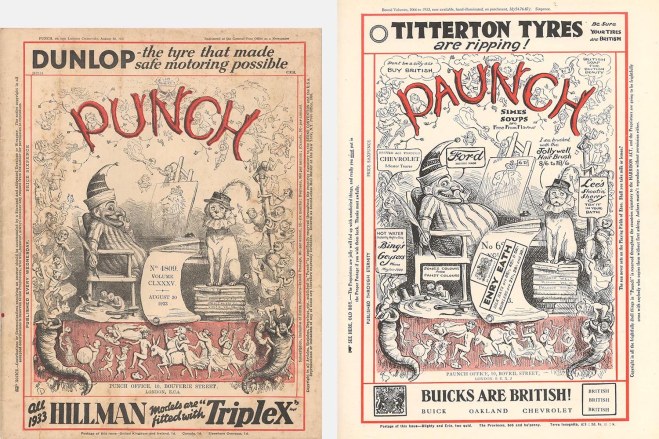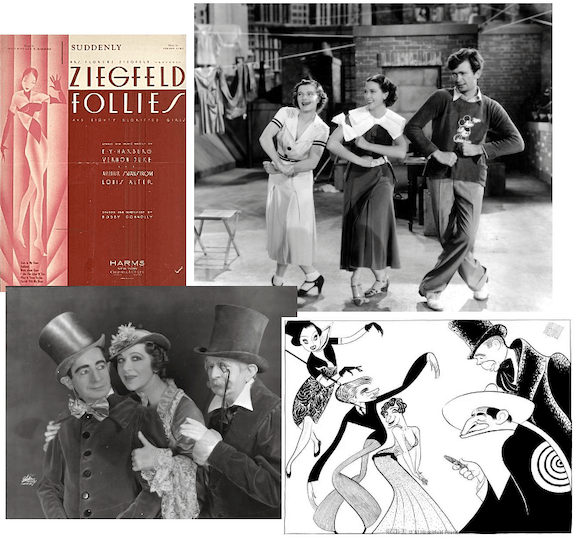In 1925 New Yorker founding editor Harold Ross wrote that he wanted his new magazine to be “humorous from a sophisticated viewpoint” and “record the situations of everyday life among intelligent and substantial people as do the English magazines, notably Punch, except that our bent is more satirical, sharper.”

Sharper indeed, as was demonstrated in the Jan. 13, 1934 issue, when Ross’s young magazine took aim at Punch, which was founded in 1841 and had grown long in the tooth under the guidance of Sir Owen Seaman, whose Victorian sensibilities (he joined Punch in 1897) were ripe for parody by a magazine founded during the Jazz Age.
Writer and cartoonist V. Cullum Rogers (MagazineParody.com) notes that the eight pages devoted to “Paunch” was The New Yorker’s longest and most elaborate parody of another publication.

E.B. White and Franklin P. Adams contributed parodies (“The Mall” by White and “The Intent Caterpillar” by Franklin) of what Rogers cites as “two of Punch’s favorite forms of bad verse: the sticky-sentimental and the mechanically clever.”
The New Yorker’s theatre critic Wolcott Gibbs joined the fun by penning “Mr. Paunch’s Cinema Review” (excerpt)…
…Rea Irvin and James Thurber offered up their cartooning skills…

…and Robert Benchley contributed this gem, “Hyacinths for Pamela.”
Rogers writes that although “Paunch” wasn’t promoted on the cover, “the issue it ran in became the first in The New Yorker’s nine-year history to sell out on newsstands. (The second sellout contained Wolcott Gibbs’s Time parody, which suggests a demand for such things).”
The parody issue concluded with this page of advertisements:
* * *
The Show Must Go On
The death of Florenz Ziegfeld Jr. in 1932 did not put an end to his Follies; indeed, under the direction of his widow, Billie Burke, the show seemed to have new legs, at least according to Robert Benchley:

* * *
Keen on the Airflow
The streamlining trend in autos was not to E.B. White’s liking (see below), but the reviewer of the National Auto Show (pseud. “Speed”) was eager to take the Chrysler Airflow for a spin.
* * *
From Our Advertisers
The Chrysler Corporation ran this two-page ad that took issue with E.B. White’s criticisms of the streamlining trend in automobiles, led by Chrysler’s “Airflow” model…here Chrysler responded with a note pinned to a tear sheet from the Dec. 16, 1933 “Talk of the Town”…You wrote this before you saw the new Chryslers, Mr. New Yorker…
…with the National Auto Show still in town the splashy car ads continued, including this one from the makers of Fisher car bodies…
…another advertising stalwart, the Liggett & Myers Tobacco Company, gave us a young woman who enjoyed their Chesterfields “a lot”…
…Guinness was back for those who missed that taste of Dublin…
…and the folks behind “The Beer That Made Milwaukee Famous” placed their first ad in The New Yorker…
…if you wanted to have your drink outside of the home, what better place than the Madison Room at The Biltmore…
…on to our cartoons, with begin with Perry Barlow and a tot losing sleep over the new year…
…Kemp Starrett also explored the world of sleep deprivation…
…and we end with James Thurber, and a woman with a low tolerance for “cute” news…
…in case you are wondering, Anna Eleanor “Sistie” Dall was the daughter of Franklin and Eleanor Roosevelt’s eldest child Anna Dall. When Dall separated from her husband in 1933, she moved into the White House with her children, Sistie and Buzzie.

Next Time: A Joycean Odyssey…




















Hi, David O —
Thanks for the shout-out to my “Paunch” post. I’m afraid I made a mistake that you compounded when I called Wolcott Gibbs The New Yorker’s “film critic” instead of “theatre critic.” You’re right that John Mosher was the mag’s film critic then, but the index says it was Gibbs, not Mosher, who wrote “Mr. Paunch’s Cinema Review.”
— Cullum Rogers
LikeLike
Hello! First off, thanks for reading my blog. I discovered your magazine parody site about a year ago and read the whole thing—fascinating, hilarious, and expertly written and researched. Thanks for the clarification; I will make the correction on my post. Regards, David
LikeLike